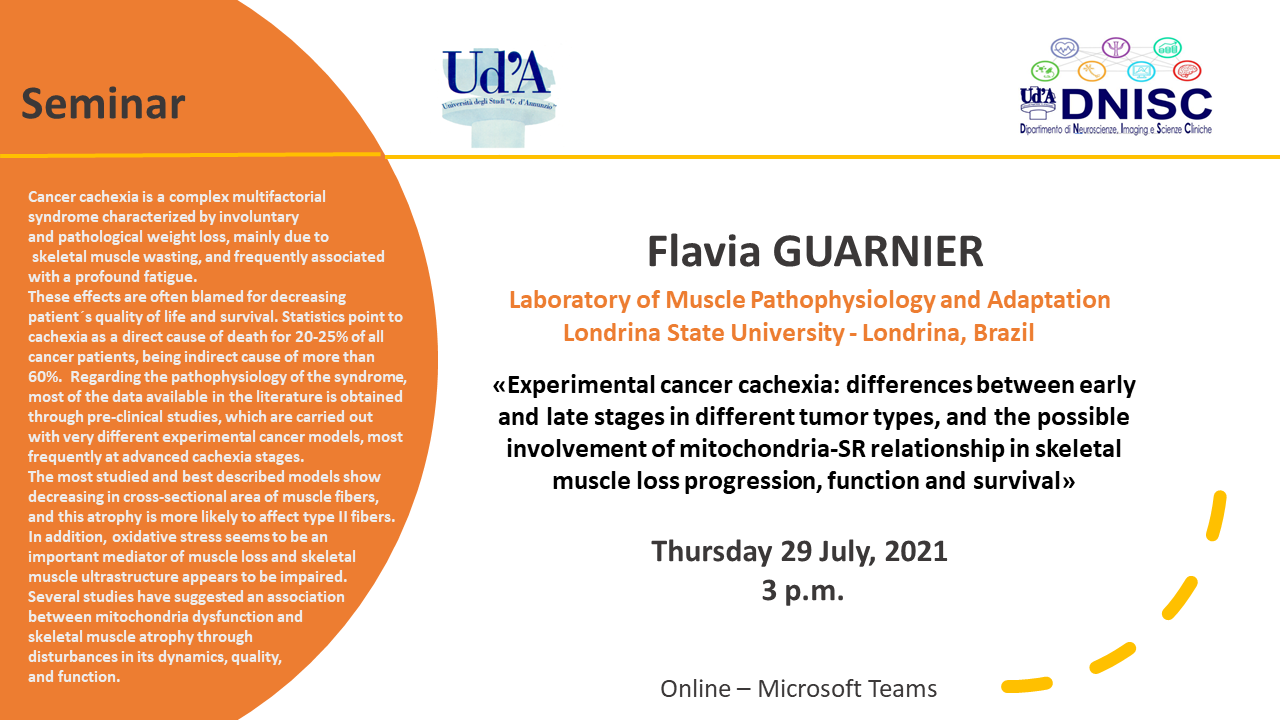Experimental cancer cachexia: differences between early and late stages in different tumor types, and the possible involvement of mitochondria-SR relationship in skeletal muscle loss progression, function and survival


SEMINARIO / SEMINAR
Titolo / Title:
Experimental cancer cachexia: differences between early and late stages in different tumor types, and the possible involvement of mitochondria-SR relationship in skeletal muscle loss progression, function and survival.
Quando / When:
29 luglio, ore 15:00 / 29th of July 2021 at 15:00 CET
Dove / Where:
Relatore / Speaker:
Flávia A. Guarnier, Laboratory of Muscle Pathophysiology and Adaptation, Londrina State University, Londrina, Brazil.
Abstract: Cancer cachexia is a complex multifactorial syndrome characterized by involuntary and pathological weight loss, mainly due to skeletal muscle wasting, and frequently associated with a profound fatigue. These effects are often blamed for decreasing patient´s quality of life and survival. Statistics point to cachexia as a direct cause of death for 20-25% of all cancer patients, being indirect cause of more than 60%. Regarding the pathophysiology of the syndrome, most of the data available in the literature is obtained through pre-clinical studies, which are carried out with very different experimental cancer models, most frequently at advanced cachexia stages. The most studied and best described models show decreasing in cross-sectional area of muscle fibers, and this atrophy is more likely to affect type II fibers. In addition, oxidative stress seems to be an important mediator of muscle loss and skeletal muscle ultrastructure appears to be impaired. Several studies have suggested an association between mitochondria dysfunction and skeletal muscle atrophy through disturbances in its dynamics, quality, and function. These changes would precede muscle loss, while mitophagy would be present at later stages, when muscle proteolysis is the predominant event. The oxidative stress, that is related to myofibrils proteolysis and atrophy at different cachexia stages, is pointed out as mitochondrial modifications responsibility. In the last years, our group has dedicated attention to investigate oxidative and ultrastructural modifications in mitochondria and sarcoplasmic reticulum (SR), and correlate with muscle loss in glycolytic and oxidative muscles in precocious stages of cancer-induced cachexia, comparing to the events shown in the late days, as the influence of proteolytic modification in survival. Recently collected data, show that, in a very early stage of an experimental model of cachexia: 1) glycolytic muscles are already more prone to mass waste, but independently of protein oxidation; 2) glycolytic fibers are already sensitive to mitochondria, and SR structural alterations; 3) these parameters are straightly correlated to membranes oxidative modifications; 4) oxidative muscles are not preserved from oxidative and structural damage; and 5) the pattern of muscle loss and structural oxidation is different among tumor types, which directly influences the adequate time for treatment and, consequently, resistance to treatment and survival. We believe these new data bring to light a useful tool to fight this devastating syndrome.
Bio: Flávia Guarnier is assistant professor in the Department of General Pathology at Londrina State University, Brazil. She delivers courses in general pathology for health-related degrees including physiotherapy, biomedicine, nursing and medicine.